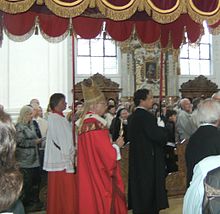Play for the birthday of the venerable Mr. Sebastian, the highly honored Regent Weingartens, on January 20, 1717
| Data | |
|---|---|
| Title: | Play for the birthday of the venerable Mr. Sebastian, the highly honored Regent Weingartens, on January 20, 1717 |
| Original title: | Drama pro natali reverendissimi domini Sebastiani, Vinearum praesulis amplissimi, anno 1717, the 20th januarii |
| Genus: | play |
| Original language: | Latin language |
| Author: | Joachim Braunmüller OSB |
| Publishing year: | 1717 |
| Premiere: | February 5, 1717 |
| Place of premiere: | Weingarten Imperial Abbey |
| people | |
|
|
The spectacle of the birthday of the venerable Mr. Sebastian, the highly honored regent vineyard, on 20 January 1717 (lat. Drama per natali reverendissimi domini Sebastiani, Vinearum Praesulis amplissimi, anno 1717, the 20th Januarii ) is one of Father Joachim Braunmüller OSB authored Play that was performed on January 20, 1717 in Weingarten Monastery , but was intended for the 50th birthday of Abbot Sebastian Hyller on February 5, 1717. The piece consists of six acts and is framed by a musical prelude and a musical aftermath. Twenty-five actors and a choir appear in the play . The piece is written in late 18th century Latin and glorifies the huge new building of the collegiate church Basilica St. Martin in Weingarten in the Ravensburg district in Upper Swabia .
history
The demolition of the old Romanesque monastery church began on March 14, 1715, two days after the date of the founder's will of 1094 . The construction of the old monastery church had started in 1124, and after 60 years of construction, it was consecrated in 1182. It was already a relatively large representative Romanesque church building, of which several images have been preserved. However, apart from a few side altars and the Hosanna bell, no parts of the inventory were taken over into Hyller's large baroque building. The old church was torn down within half a year. The foundation stone of today's basilica was laid on August 22, 1715 and consecrated on September 10, 1724 by the Prince-Bishop of Constance Johann Franz Schenk von Stauffenberg .
The legacy of the Baroque period is visible in both secular and religious buildings, paintings , sculptures , literature and music . The baroque drama is little known. In the monasteries, theater was performed several times during the year on specially existing stages. Popular dates were the abbot's name day , the feast of the respective religious saint or at the beginning and end of the school year.
action
After a musical prelude in the first act, a person named Kirchele-Mann holds a monologue with a model of the old church on his back, in front of the backdrop of the new church building that is currently being built . He laments the destruction of the old church building. In the next elevator, Solicitudo and Curiositas discuss the financial viability of church building. Curiosity refers to the steady stream of pilgrims who come to Weingarten every year to attend the relic of the Holy Blood and thus receive the legitimacy of such a mighty church. In another elevator, Vinea and the procurator consider whether the construction, which was two years earlier in 1717, will continue as before without financial or structural problems. Then two friends of Vinea appear who congratulate her on her birthday and want to know more about Vinea's treasure. Thereupon four treasure hunters appear with tools and a dowsing rod , who try to lift a treasure, but fall into an underground dung pit.

In the final elevator, the curtain rises over the treasure of the monastery. The props consist of an imperial and royal crown, sceptres and swords and a chest . Vinea explains the treasure of the monastery and opens the chest. It is full of skulls and bones of the Guelph founders of the monastery.
This is followed by the musical aftermath in which Vinea and Austria , the personification of Austria, sing about the value of the treasure.
From the divine blood, from this pious seed, Austria blossoms and becomes rich in vineyards.
The piece ends with the congratulations to the abbot on his 50th birthday, who is presented with a sign. The present play has an important event in the monastery state at that time: the new building of the central sanctuary, which is reliably propagated in the play. The play gives testimony to the cultural life in the baroque era. The scores for the piece have not yet been found.
Brigantis e montibus murarii
The Latin phrase Brigantis e montibus murarii can be translated as mason from the Bregenz Forest or mason from the robber mountains . Again and again in the play the builders from the Bregenz Forest, the Auer guild , are pestered, sometimes insulted as Schmalz-Säckha . They are accused of overcharging the church, of wanting to build the church out of lard, cheese, butter and fat.
Vos, vos! Brigantinis e montibus murarii, lignarii, isti Waldenses ad omnen luctum meum antesisignani fuere: putant, "die Schmalz-Säckhä", se novos illoco muros ex caseis compacturos, glutine ex butyro et adipe congestos (...)
The verbal abuse also revolves around the word Wäldler, which can also be understood as a Waldensian of a heretical sect . The builders are suspected of being heretics.
literature
- Norbert Kruse, The new building of the baroque monastery church in Weingarten: Glorification and lament in a play from 1717 , in Im Oberland, volume 1, 2009
Web links
Individual evidence
- ^ Norbert Kruse: The way of the Holy Blood from Mantua to Altdorf-Weingarten , in 900 years of adoration of the Holy Blood in Weingarten, 1094-1994 , 1994
- ^ Norbert Kruse, The new building of the baroque monastery church in Weingarten: Glorification and lament in a play from 1717 , in Im Oberland, No. 1, 2009, p. 20